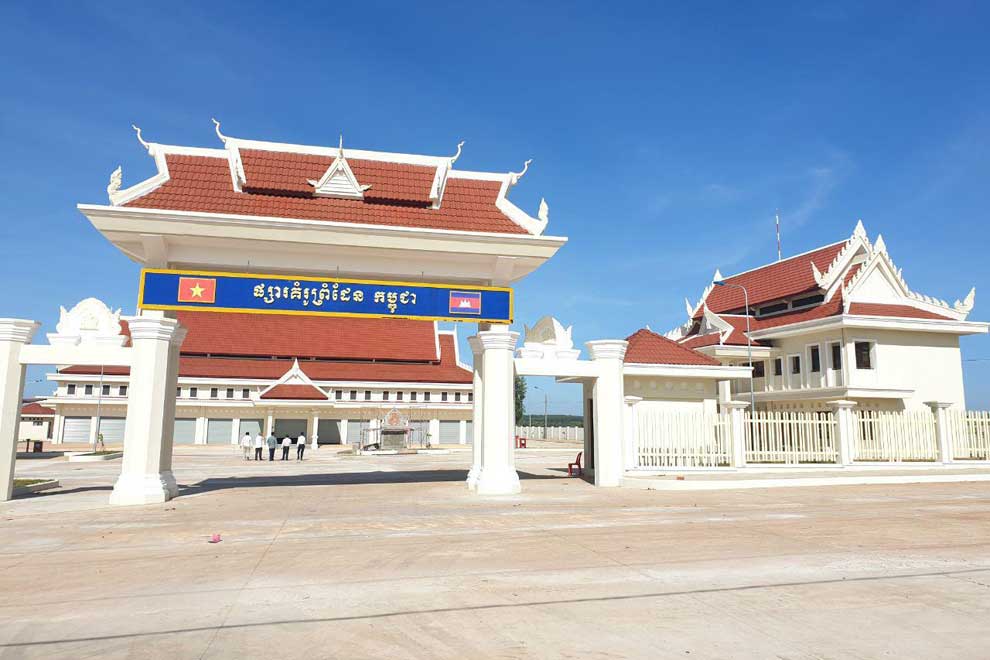
The border markets represent an effort to improve exports to Vietnam and develop border communities. Fresh News
Two planned frontier markets in Svay Rieng and Kampot provinces have yet to break ground, relevant provincial authorities said on Tuesday.
Prime Minister Hun Sen has ordered the Ministry of Commerce to work with Svay Rieng and Kampot officials to build two additional border markets in a bid to shore up border trade and enhance cooperation with Cambodia’s neighbour Vietnam.
He said this at an inauguration ceremony for the Da Market in Tbong Khmum province near the Vietnamese border on December 24.
A model market
He hailed the construction of the market, saying it would serve as a model for future projects launched in the interest of facilitating trade, propping up small and large businesses and providing the people of both countries with a fair market that will help uplift their livelihoods.
“I hope that [Da Market] becomes a model market for us [in promoting] the trade of goods. If the project fails, plans to set up similar markets in other provinces will also fail,” Hun Sen said.
He tasked the ministry with exploring potential sites for the market and assessing their feasibility.
“The market is designed to benefit exports to Vietnam. We want to use the national budget to build them. I support this initiative to develop and transform border communities,” he said, adding that he wanted the design of the market to have a distinct traditional Khmer flavour.
According to minister Pan Sorasak, Cambodian and Vietnamese officials signed a memorandum of understanding in July 2017 to begin work on the Da Market.
Officials broke ground on the 19,628sqm market in Memot district’s Thary Tbong Khmum Special Economic Zone in February 2018 thanks to a $2 million grant from the Vietnamese government, he said.
Kampot settles on location
Kampot provincial governor Cheav Tay told The Post on Tuesday that provincial authorities and ministry officials had settled on a site near the Prek Chak International Border Checkpoint in southeastern Kampong Trach district’s southwestern Russey Srok Khang Lech commune, across from Vietnam’s Kien Giang province.
They are working to prepare a detailed assessment of the site before breaking ground on the project.
“It has yet to begin due to Covid-19. The ministry has not set a specific timeframe for construction,” he said, pointing out that a groundbreaking hinges on the ministry’s green light.
He voiced his confidence that the border market would provide a substantial impetus for goods exchange between Cambodians and Vietnamese.
Svay Rieng undecided
Svay Rieng Provincial Hall spokesman Ros Pharith said two potential sites are under review for the border market in his province, with authorities weighing on which would better provide long-term development potential.
He said one site is in the east and adjacent to Vietnam’s Tay Ninh province, while the other is in the south and across from Long An province.
In addition to accelerating development in border areas, he said, such markets are in line with the government’s policy to turn the Kingdom’s frontiers into zones of peace and good cooperation with neighbouring countries.
“It’d be a bit hasty to confirm where the two locations are – the team has not made an official decision. But a joint inspection conducted by provincial authorities and the Ministry of Commerce has come to an end.
“Development growth is gaining steam in consonance with the added infrastructure and markets at the border. Of note is how much easier it makes for locals to trade in agricultural products,” Pharith said.
Bilateral trade slips
Ministry spokesman Pen Sovicheat said construction on the two markets could begin as early as next year, noting that the 2021 budget has an undisclosed amount earmarked for the project.
Bilateral trade between Cambodia and Vietnam dipped 8.1 per cent year-on-year to $2.17 billion in the first five months of this year, according to the Vietnamese Embassy in Phnom Penh.
Cambodia exported $476 million worth of products to the Vietnamese market during the period, down 15 per cent, and imported $1.7 billion, down six per cent, it repoted, citing data from Vietnam’s General Department of Customs.
The embassy said Cambodia mainly exported paddy, milled rice, cashew nuts, natural rubber, tobacco leaves and bananas to Vietnam, and imported steel, oil, vegetables, fruits and fertilisers.
Vietnamese ambassador to Cambodia Vu Quang Minh previously said bilateral trade between Cambodia and Vietnam reached nearly $5.3 billion last year, up 11 per cent compared to 2018.
The Kingdom exported $901 million worth of products last year, a seven per cent year-on-year surge, and imported $4.4 billion, gaining 16 per cent year-on-year, Minh said.
He said Vietnam currently has 214 registered projects in the Kingdom worth a total investment of $3.074 billion. Of these, 176 were ongoing with a total registered capital of $2.77 billion.
Shared land border
The two countries share a 1,137km land border which passes through nine Cambodian provinces – Kampot, Takeo, Kandal, Prey Veng, Svay Rieng, Tbong Khmum, Kratie, Mondulkiri and Rattanakiri and ten Vietnamese provinces of Kien Gian, An Giang, Dong Thap, Long An, Tay Ninh, Binh Phuoc, Dak Nong, Dak Lak, Gia Lai and Kon Tum.
In Cambodia’s south, Vietnam borders Kampot province’s Banteay Meas and Kampong Trach districts; Takeo province’s Kiri Vong, Koh Andet and Borei Cholsar districts; Kandal province’s Koh Thom and Loeuk Dek districts.
It also borders Prey Veng province’s Peam Chor, Preah Sdech, Kampong Trabek and Kamchay Mear districts; and Svay Rieng province’s Svay Chrum, Kampong Ro, Chantrea, Svay Teap, Romduol and Romeas Hek districts and Bavet town.
In Cambodia’s east, it borders Tbong Khmum province’s Ponhea Kraek and Memot districts; Kratie province’s Snuol district; Mondulkiri province’s Keo Seima, O’Raing, Pech Chreada and Koh Nhek districts; and Ratanakkiri province’s O’Yadav, Andong Meas, Taveng and Veun Sai districts.











